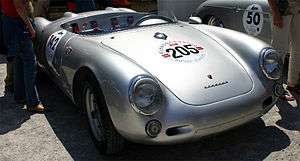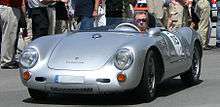Porsche 550
| Porsche 550 | |
|---|---|
 | |
| Overview | |
| Manufacturer | Porsche |
| Production | 1953-1956 (90 produced) |
| Assembly | Stuttgart, Germany |
| Body and chassis | |
| Class | Sports car |
| Body style |
2-door coupé 2-door spyder |
| Layout | RMR layout |
| Powertrain | |
| Engine | 1.5L (1,498 cc) DOHC Flat four engine |
| Transmission |
4-speed manual 5-speed manual |
| Dimensions | |
| Wheelbase | 2100 mm (82.7 in) |
| Length | 3700 mm (145.7 in) |
| Width | 1610 mm (63.4 in) |
| Height | 980 mm (38.6 in) |
| Curb weight | approximately 550 kg (1,212 lbs) |
| Chronology | |
| Successor | Porsche 718 |
The Porsche 550 was a racing sports car produced by Porsche from 1953-1956.
Engine and Transmission
The Type 550/550 A is powered by an all aluminum 1,498 cc (1.5 L; 91.4 cu in) naturally aspirated aircooled 4 cylinder boxer engine known as the "Fuhrmann Engine" (Type 547).[1] It uses four camshafts (two on each side) driven by vertical shafts, so the valvetrain configuration is DOHC with 2 valves per cylinder, equipped with twin 2-barrel Solex PJJ carburetors and dual ignition with two separate ignition manifolds and two ignition coils as well as two double fall gasifiers. In its first version produced 110 PS (108 hp; 81 kW) @ 6200 rpm and a maximum torque of 121 N⋅m (89 lb⋅ft) @ 5000 rpm [2] [3] [4] [5].
The engine of the 550 is mounted in front of the rear axle making it mid-engined. This gives it a more balanced weight distribution, and allows for largely neutral handling. On the other hand, the low mass moment of inertia about the vehicle's vertical axis can lead to a sudden, difficult to control rotation of the car. Porsche used this design principle already in the Grand Prix car of the Auto Union in the late 1930s.
The first 550 had a fully synchronized 4-speed gearbox. Starting in 1956, a five-speed gearbox was used, but its first gear only had to start and (like the reverse gear) had to be placed over a barrier and not synchronized. Excessive slip on the drive wheels in corners prevented a limited slip differential.[6]
History


Inspired by the Porsche 356 which was created by Ferry Porsche, as well as spyder prototypes built and raced by Walter Glöckler starting in 1951, the factory decided to build a car designed for use in auto racing.[7] The Porsche 550 Spyder was introduced at the 1953 Paris Auto Show.[8] The 550 was very low to the ground, in order to be efficient for racing. In fact, former German Formula One racer Hans Herrmann drove it under closed railroad crossing gates during the 1954 Mille Miglia.
Racing history
The first three hand built prototypes came in a coupé with a removable hardtop. The first (550-03) raced as a roadster at the Nurburgring Eifel Race in May 1953 winning its first race. Over the next couple of years, the Werks Porsche team evolved and raced the 550 with outstanding success and was recognized wherever it appeared. The Werks cars were provided with differently painted tail fins to aid recognition from the pits. Hans Herrmann’s particularly famous ‘red-tail’ car No 41 went from victory to victory. Porsche was the first car manufacturer to get race sponsorship which was through Fletcher Aviation, who Porsche was working with to design a light aircraft engine and then later adding Telefunken and Castrol.
For such a limited number of 90 prototype and customer builds, the 550 Spyder was always in a winning position, usually finishing in the top three results in its class. The beauty of the 550 was that it could be driven to the track, raced and then driven home, which showed the flexibility of being both a road and track car. Each Spyder was individually designed and customised to be raced and although from the pits it was difficult to identify the sometimes six 550s in the race, the aid of colouring tail spears along the rear wheel fenders, enabled the teams to see their cars. The racing Spyders were predominantly silver in colour, similar to the factory colour of the Mercedes, but there were other splashes of blue, red, yellow and green in the tail spears making up the Porsche palette on the circuit.
Each Spyder was assigned a number for the race and had gumballs positioned on doors, front and rear, to be seen from any angle. On some 550s owned by privateers, a crude hand written number scrawled in house paint usually served the purpose. Cars with high numbers assigned such as 351, raced in the 1000 mile Mille Miglia, where the number represented the start time of 3.51am. On most occasions, numbers on each Spyder would change for each race entered, which today helps identify each 550 by chassis number and driver in period black and white photos.
The later 1956 evolution version of the model, the 550A, which had a lighter and more rigid spaceframe chassis, gave Porsche its first overall win in a major sports car racing event, the 1956 Targa Florio.
Its successor from 1957 onwards, the Porsche 718, commonly known as the RSK was even more successful. The Spyder variations continued through the early 1960s, the RS 60 and RS 61. A descendant of the Porsche 550 is generally considered to be the Porsche Boxster S 550 Spyder; the Spyder name was effectively resurrected with the RS Spyder Le Mans Prototype.
James Dean's "Little Bastard"
Perhaps the most famous of the first 90 Porsche 550s built was James Dean's "Little Bastard", numbered 130 (VIN 550-0055), which collided with Donald Turnupseed's 1950 Ford Custom at the CA Rte. 46/41 Cholame Junction on September 30, 1955, resulting in Dean's death.[9]
As Dean was finishing up Giant’s filming in September, 1955, he suddenly traded in his 356 Porsche Super Speedster at Competition Motors, for a new 1955 Porsche 550 Spyder on September 21st, and immediately entered the upcoming Salinas Road Race event scheduled for October 1 and 2.[10]
According to Lee Raskin, Porsche historian and author of James Dean At Speed, Dean asked custom car painter and pin striper Dean Jeffries to paint "Little Bastard" on the car:
Dean Jeffries, who had a paint shop next to [George] Barris did the customizing work which consisted of: painting '130' in black non-permanent paint on the front hood, doors and rear deck lid. He also painted 'Little Bastard' in script across the rear cowling. The red leather bucket seats and red tail stripes were original. The tail stripes were painted by the Stuttgart factory, which was customary on the Spyders for long distance endurance racing identification.[11]
Purportedly, James Dean had been nicknamed "Little Bastard" by Bill Hickman, a Warner Bros. stunt driver who became friendly with him. (Previous references to Hickman say he was Dean's dialogue coach on Giant, though Bob Hinkle, a Texan, was actually Dean's Giant dialogue coach.) Hickman was part of Dean's group driving to the Salinas Road Races on September 30, 1955. Hickman says he called Dean, "Little Bastard", and Dean called Hickman, "Big Bastard."
Another origin story of the "Little Bastard" monicker has been corroborated by two of Dean's close friends, Lew Bracker and photographer Phil Stern. They believe Jack L. Warner of Warner Bros. had once referred to Dean as a "little bastard" after Dean refused to vacate his temporary East of Eden trailer on the studio's lot, and Dean wanted to get "even" with Warner by naming his race car "Little Bastard" and to show Warner that despite his sports car racing ban during all filming, Dean was going to be racing the "Little Bastard" in between making movies for Warner Bros.[12]
Replicas

The 550 is among the most frequently reproduced classic automobiles. [13]
Several companies have sprung up in the last 25 years that offer kit and turnkey cars, including:
- Le Mans 550 Spyder (Out of business) Website: NA
- Seduction Motorsports (Chandler, Arizona) Website: www.seductionmotorsports.com
- Vintage Spyders (Stanton, California)
- Kitman Motors (Out of business) Website: www.kitmanmotors.com
- Rock West Racing (Out of business) Website: NA
A few other companies build near-exact replicas from the ground up, fabricating 550 turn-key cars to the buyer's exact specifications, including:
- Alloycars, which specializes in exact aluminum recreations from blueprints.
- 502 MotorworksOnly builder of FIA homologated alloy Spyders to date.
References
| Wikimedia Commons has media related to Porsche 550 Spyder. |
- ↑ "1955 - 1956 Porsche 550 Spyder Review @ Top Speed". Top Speed. Retrieved 2018-04-05.
- ↑ "Type 547 engine | Type 550". type550.com. Retrieved 2018-04-05.
- ↑ "1954 Porsche 550 RS Spyder". Supercars.net. Retrieved 2018-06-09.
- ↑ "Porsche 550 RS Spyder". ultimatecarpage.com. Retrieved 2018-06-09.
- ↑ "Porsche 550/1500 RS Spyder". Automobile-catalog. Retrieved 2018-06-09.
- ↑ "RS550 specs | Type 550". type550.com. Retrieved 2018-04-05.
- ↑ Leffingwell, Randy (2002). Porsche legends. Osceola, WI: MBI Pub. Co. p. 35. ISBN 0-7603-1364-4.
- ↑ "Porsche History - Milestones". Retrieved 2009-05-05.
- ↑ Raskin, Lee (July 1984). "Porsche Panorama". Little Bastard: Search for James Dean's Spyder. Porsche Club of America, Inc. pp. 12–16, 19–20. ISSN 0147-3565.
- ↑ Raskin, Lee (2005). James Dean: At Speed. Phoenix, Ariz.: David Bull. pp. 101–102. ISBN 978-1-893618-49-7.
- ↑ "'Little Bastard': The Silver Spyder Porsche/Dean Mystery Revisited". The Selvedge Yard. December 27, 2009. Retrieved 2013-02-05.
- ↑ Raskin, p. 106.
- ↑ "The Most Commonly Replicated Classic Cars". Hagerty Magazine. 2014-02-21. Retrieved 2016-02-06.